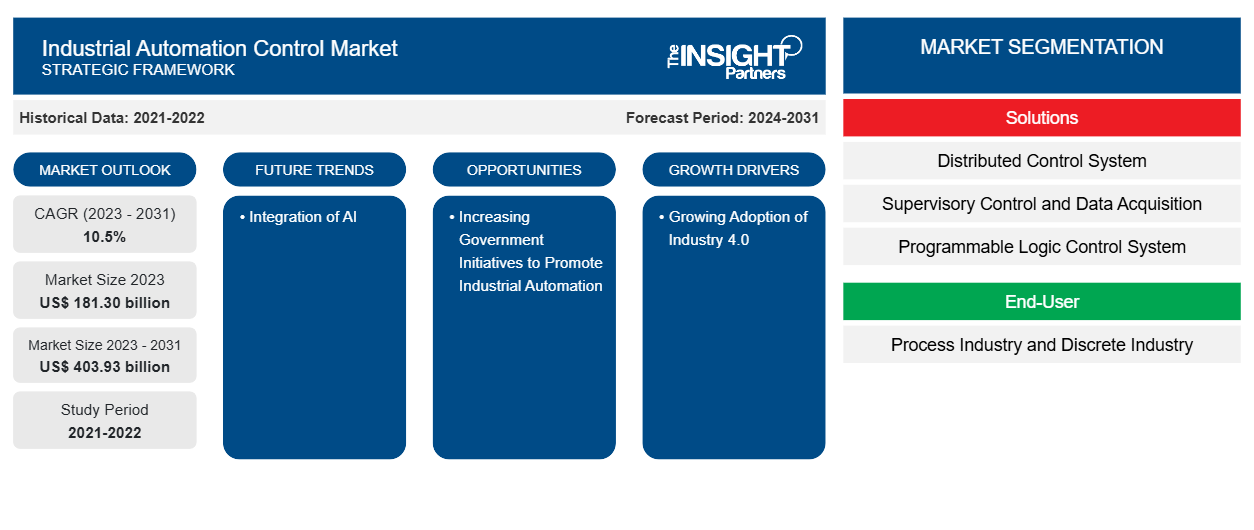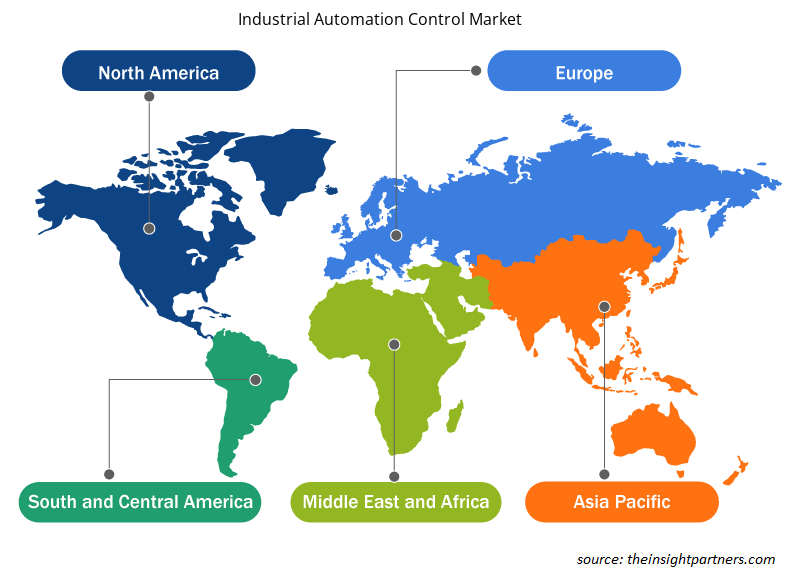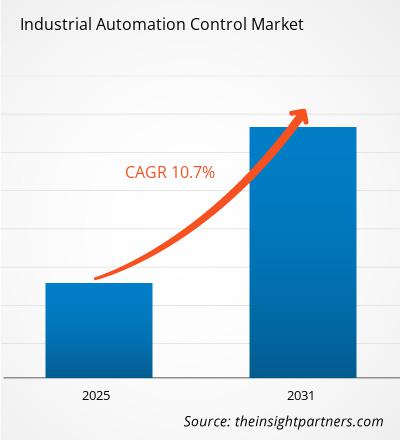産業オートメーション制御市場規模は、2024年の1,932.2億米ドルから2031年には3,916.3億米ドルに達すると予測されています。市場は2025年から2031年にかけて年平均成長率(CAGR) 10.7%を記録すると予想されています。人工知能(AI)と機械学習(ML)の統合は、今後数年間で市場に新たなトレンドをもたらすと予想されます。
産業オートメーション制御市場分析
製造業における自動化は、組立ラインや包装工程の制御から、精密機械加工や化学製品製造といった複雑な作業の監視まで、幅広い分野に及んでいます。リアルタイムのデータ収集と分析により、自動化システムは障害検知、メンテナンスの必要性予測、ワークフローの最適化を実現し、故障やダウンタイムの削減につながります。その結果、市場の変化や消費者の需要に迅速に対応できる、より俊敏な生産環境が実現します。産業オートメーション制御は、人為的ミスの削減と運用監視の強化により、職場の安全性向上にも重要な役割を果たします。企業にとっては、大幅なコスト削減、生産サイクルの短縮、そしてより効果的な事業拡大につながります。産業界が自動化技術の導入を継続することで、競争力とイノベーションを高め、デジタル化とグローバル化が進む市場において長期的な成長と成功を実現することができます。
産業オートメーション制御市場の概要
産業オートメーション制御とは、コンピュータ、ロボット、情報システムなどの高度な技術と制御システムを用いて、産業プロセスや機械を管理・監視することを指します。産業オートメーション制御の目的は、製造工程における人的介入を減らすことで、効率性、生産性、安全性を向上させることです。ビジネスにおいて、産業オートメーション制御は、反復的で時間のかかる作業を自動化することで生産を効率化し、より迅速で正確かつ一貫した出力を実現します。自動化によって、企業は高い製品品質を維持しながら、業務効率の向上、エラーリスクの低減、人件費の最小化を実現できます。これらのシステムには、センサー、ロボット工学、人工知能(AI)が統合されていることが多く、生産ラインをリアルタイムで監視・制御し、調整を行うことでパフォーマンスを向上させ、無駄を削減します。
要件に合わせてレポートをカスタマイズ
このレポートの一部、国レベルの分析、Excelデータパックなど、あらゆるレポートを無料でカスタマイズできます。また、スタートアップや大学向けのお得なオファーや割引もご利用いただけます。
産業オートメーション制御市場:戦略的洞察

- このレポートの主要な市場動向を入手してください。この無料サンプルには、市場動向から見積もりや予測に至るまでのデータ分析が含まれます。
産業オートメーション制御市場の推進要因と機会
多様な産業における産業オートメーション制御の普及
自動車業界以外の業界でも、産業オートメーション制御の普及が加速しています。近年、自動車業界に比べて非自動車業界の普及は非常に遅れていました。産業用ロボットなどの機器の高機能化に伴い、非自動車業界における産業オートメーション制御の導入はさらに加速すると予想されます。
産業分野以外では、各国間での普及率も上昇しています。中国、米国、日本などの先進市場では普及率が高くなっていますが、先進市場においても、産業市場がさらに成長する機会は依然として大きく残されています。例えば、2023年には中国は総生産の35%を占め、これは米国の総生産のほぼ3倍に相当し、12%で第2位となります。これらの国々の多く、特に自動車産業以外の産業において、さらなる導入の見通しは顕著です。この成長は、これらの市場で求められている近代化と変革に起因しています。これらの統計は、採用がさらに拡大する大きな余地があることを示しているため、製造業者にとって有望です。
政府の支援の増加
世界中の産業界が効率性の向上と製造プロセスの合理化を目指す中、政府と政策立案者による産業オートメーション制御の推進の重要性は著しく高まっています。産業オートメーション制御は第四次産業革命の推進において極めて重要な役割を果たすため、政府と政策立案者は、その広範な導入と成長を促進するための適切な支援メカニズムと規制枠組みを確立する必要があります。例えば、インドでは、政府はスマート製造セクターを強化するための複数の施策を実施しており、その主要な取り組みの一つが生産連動インセンティブ(PLI)制度です。2020年に開始されたPLI制度は、自動車、医薬品、繊維、食品加工、白物家電など14セクターを対象としており、国内製造業を促進するための広範な戦略の一環です。この制度は、現地で製品を生産し、特定の投資、売上、輸出基準を満たす企業に金銭的インセンティブを提供することで、企業によるスマート製造の導入を促進することを目的としています。この取り組みは、これらの企業の競争力を高め、ひいてはインドの製造業全体の価値向上を目指しています。PLI(スマート製造業促進プログラム)スキーム。2020年に開始されたPLIスキームは、自動車、医薬品、繊維、食品加工、白物家電など14セクターを対象としており、国内製造業の振興に向けた広範な戦略の一環です。このスキームは、現地で製品を生産し、特定の投資、売上、輸出基準を満たす企業に金銭的インセンティブを提供することで、企業によるスマート製造の導入を促進することを目的としています。この取り組みは、これらの企業の競争力を高め、ひいてはインドの製造業全体の価値向上を目指しています。
同様に、米国では2023年にエネルギー省(DoE)が、中小規模の施設におけるスマート製造の導入を促進するため、12の州立プログラムを支援する2,200万米ドルのイニシアチブを発表しました。大統領の超党派インフラ法によって資金提供されるこのイニシアチブは、米国製造業におけるスマート製造技術と高性能コンピューティングへのアクセスを強化することを目的としています。さらに、2023年8月には、製造業向け先進ロボット工学研究所(ARM)が8つの新たな短期サイクル技術プロジェクトを最終候補に挙げ、23-01技術プロジェクトコールを通じて総額約326万米ドルの資金提供を行う予定です。こうしたイニシアチブは、スマート製造分野を後押しする大きな機会を提供し、ひいては産業オートメーション制御市場の成長を促進することが期待されています。
産業オートメーション制御市場レポートのセグメンテーション分析
産業オートメーション制御市場分析の導出に貢献した主要なセグメントは、システムとエンドユーザーです。
- システム別に見ると、産業オートメーション制御市場はSCADA、DCS、PLC、PLM、その他に分類されます。2024年にはSCADAセグメントが市場を席巻しました。
- エンドユーザーに基づいて、産業オートメーション制御市場はプロセス産業とディスクリート産業に分かれています。2024年には、ディスクリート産業セグメントが市場の大部分を占めました。
産業オートメーション制御市場シェア分析(地域別)
産業オートメーション制御市場は、北米、ヨーロッパ、アジア太平洋、中東・アフリカ(MEA)、南米の5つの主要地域に区分されています。2024年には北米が市場を支配しました。
北米全域において、技術革新が市場競争の激化を促し、イノベーションと経済力の拠点としての地位を確立しています。この地域の企業は、高品質な製品とサービスに対する高まる需要に最も効率的に対応するために、ビジネスプロセスを継続的に最適化しています。
産業オートメーション制御市場の成長をさらに促進するため、グローバル企業が様々な取り組みを行っています。例えば、2024年12月、ONDEX Automation(以下「ONDEX」または「当社」)は、ニュージャージー州ムーアズタウンに本社を置く制御システムおよび産業オートメーションサービスのリーディングカンパニーであるAutomation & Control Inc.(以下「ACI」)との提携を完了したことを発表しました。この戦略的提携は、北米の製造業顧客に革新的なオートメーションソリューションを提供するというONDEX Automationの使命において、重要な節目となります。シカゴに拠点を置くプライベートエクイティファームであるShore Capital Partnersの支援を受け、ONDEX Automationは北米の製造業顧客のニーズに応えるリーディングシステムインテグレーターを構築しています。ONDEXは、多様な能力、経験豊富なエンジニアリング人材、そしてイノベーションと卓越性への共通のコミットメントを持つファクトリーオートメーションシステムインテグレーターとの提携機会を積極的に模索しています。北米の産業オートメーション制御市場の主要プレーヤーには、Rockwell Automation Inc.、ABB Ltd.、三菱電機株式会社などが挙げられます。これらの企業は、この地域におけるイノベーションを推進し、産業オートメーションの未来を形作っています。
産業オートメーション制御市場の地域別洞察
Insight Partnersのアナリストは、予測期間全体を通して産業オートメーション制御市場に影響を与える地域的な動向と要因を詳細に解説しています。このセクションでは、北米、ヨーロッパ、アジア太平洋、中東・アフリカ、中南米における産業オートメーション制御市場のセグメントと地域についても解説します。

- 産業オートメーション制御市場の地域別データを入手
産業オートメーション制御市場レポートの範囲
| レポート属性 | 詳細 |
|---|---|
| 2024年の市場規模 | 1,932億2,000万米ドル |
| 2031年までの市場規模 | 3,916億3,000万米ドル |
| 世界のCAGR(2025年~2031年) | 10.7% |
| 履歴データ | 2021-2023 |
| 予測期間 | 2025~2031年 |
| 対象セグメント | システム別
|
| 対象地域と国 | 北米
|
| 市場リーダーと主要企業の概要 |
|
産業オートメーション制御市場のプレーヤー密度:ビジネスダイナミクスへの影響を理解する
産業オートメーション制御市場は、消費者の嗜好の変化、技術の進歩、製品メリットへの認知度の向上といった要因によるエンドユーザー需要の増加に牽引され、急速に成長しています。需要の増加に伴い、企業は製品ラインナップの拡充、消費者ニーズへの対応のためのイノベーション、そして新たなトレンドの活用を進めており、これが市場の成長をさらに加速させています。
市場プレーヤー密度とは、特定の市場または業界内で事業を展開する企業または会社の分布を指します。これは、特定の市場空間における競合企業(市場プレーヤー)の数が、その市場規模または市場価値全体と比較してどれだけ多いかを示します。
産業オートメーション制御市場で事業を展開している主要企業は次のとおりです。
- ABB株式会社
- ハネウェルインターナショナル株式会社
- シーメンスAG
- エマーソンエレクトリック社
- ボッシュ・レックスロスAG
- ゼネラル・エレクトリック・カンパニー
免責事項:上記の企業は、特定の順序でランク付けされているわけではありません。

- 産業オートメーション制御市場のトップキープレーヤーの概要を入手
産業オートメーション制御市場のニュースと最近の動向
産業オートメーション制御市場は、主要な企業出版物、協会データ、データベースなどを含む一次調査および二次調査を経て、定性・定量データを収集することで評価されます。産業オートメーション制御市場における動向のいくつかを以下に示します。
- Bosch Rexroth は、自動化分野における BODAS エコシステムを 2 つの新しいソリューションで拡張しています。衝突回避システムは、レーダー、超音波、スマート カメラを使用した正確な物体検出と人物検出を通じて、効果的な衝突防止を可能にします。
(出典:ボッシュ・レックスロス、プレスリリース、2025年)
- ABBは、既存のプロセス制御システムを最新化するためのハードウェア製品ポートフォリオであるABB Ability Symphony Plus SDeシリーズを発表しました。このシリーズは、プラント操業へのリスクと中断を最小限に抑えながら、既存のプロセス制御システムを近代化するのに役立ちます。この新シリーズにより、電力、水道、石油・ガス、製薬、パルプ・紙などの業界のプラント事業者は、既存の制御システムを最新技術にアップグレードし、効率性と生産性を向上させることができます。
(出典:ABB、プレスリリース、2024年)
産業オートメーション制御市場レポートの対象範囲と成果物
「産業オートメーション制御市場の規模と予測(2021〜2031年)」では、以下の分野を網羅した市場の詳細な分析を提供しています。
- 産業オートメーション制御市場の規模と予測(スコープに含まれるすべての主要市場セグメントの世界、地域、国レベル)
- 産業オートメーション制御市場の動向、推進要因、制約、主要な機会などの市場動向
- 詳細なPEST分析とSWOT分析
- 主要な市場動向、世界および地域の枠組み、主要プレーヤー、規制、最近の市場動向を網羅した産業オートメーション制御市場分析
- 産業オートメーション制御市場における市場集中、ヒートマップ分析、主要プレーヤー、最近の動向を網羅した業界の展望と競争分析
- 詳細な企業プロフィール
- 過去2年間の分析、基準年、CAGRによる予測(7年間)
- PEST分析とSWOT分析
- 市場規模価値/数量 - 世界、地域、国
- 業界と競争環境
- Excel データセット
最新レポート
お客様の声
購入理由
- 情報に基づいた意思決定
- 市場動向の理解
- 競合分析
- 顧客インサイト
- 市場予測
- リスク軽減
- 戦略計画
- 投資の正当性
- 新興市場の特定
- マーケティング戦略の強化
- 業務効率の向上
- 規制動向への対応




















 無料サンプルを入手 - 産業オートメーション制御市場
無料サンプルを入手 - 産業オートメーション制御市場